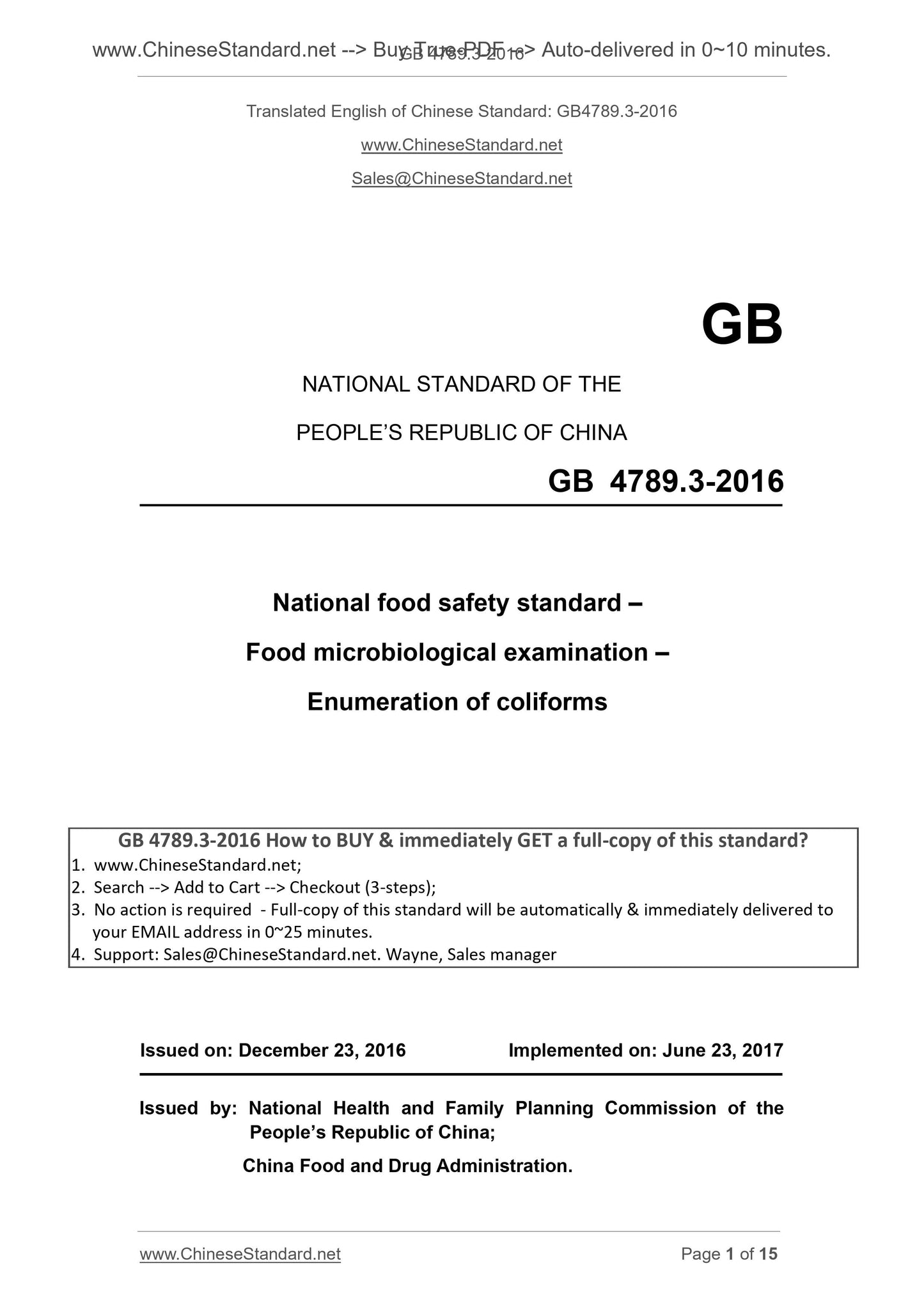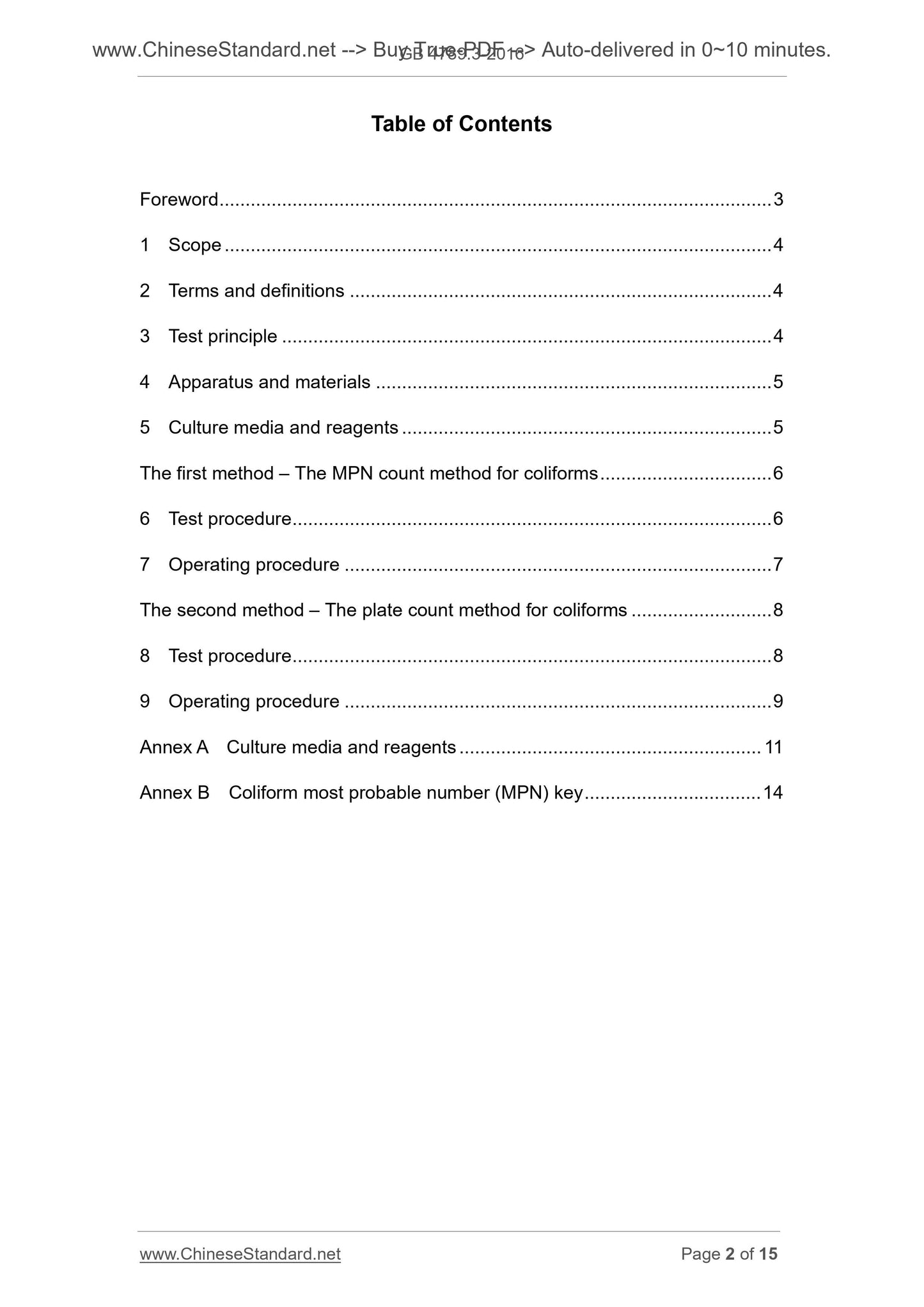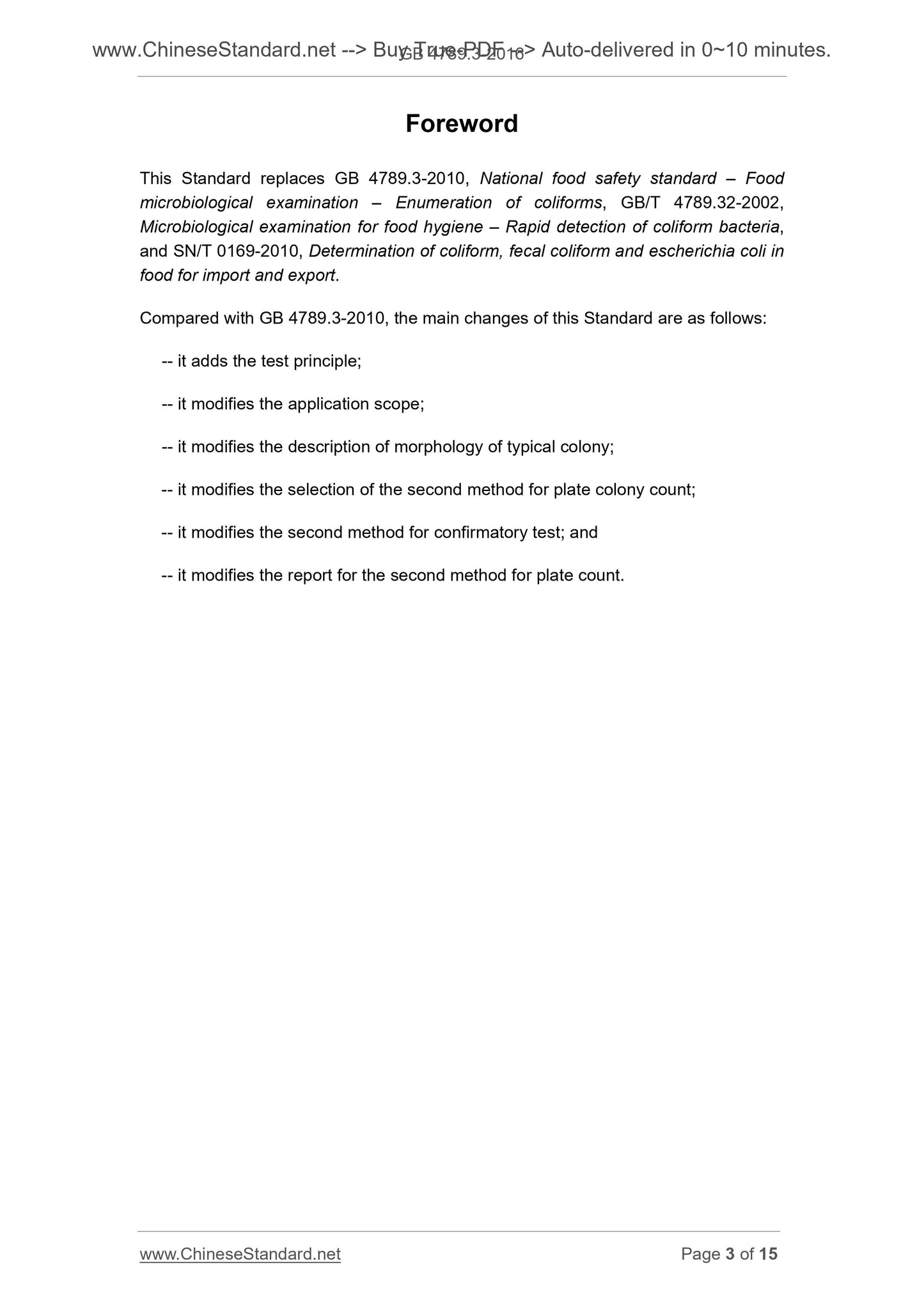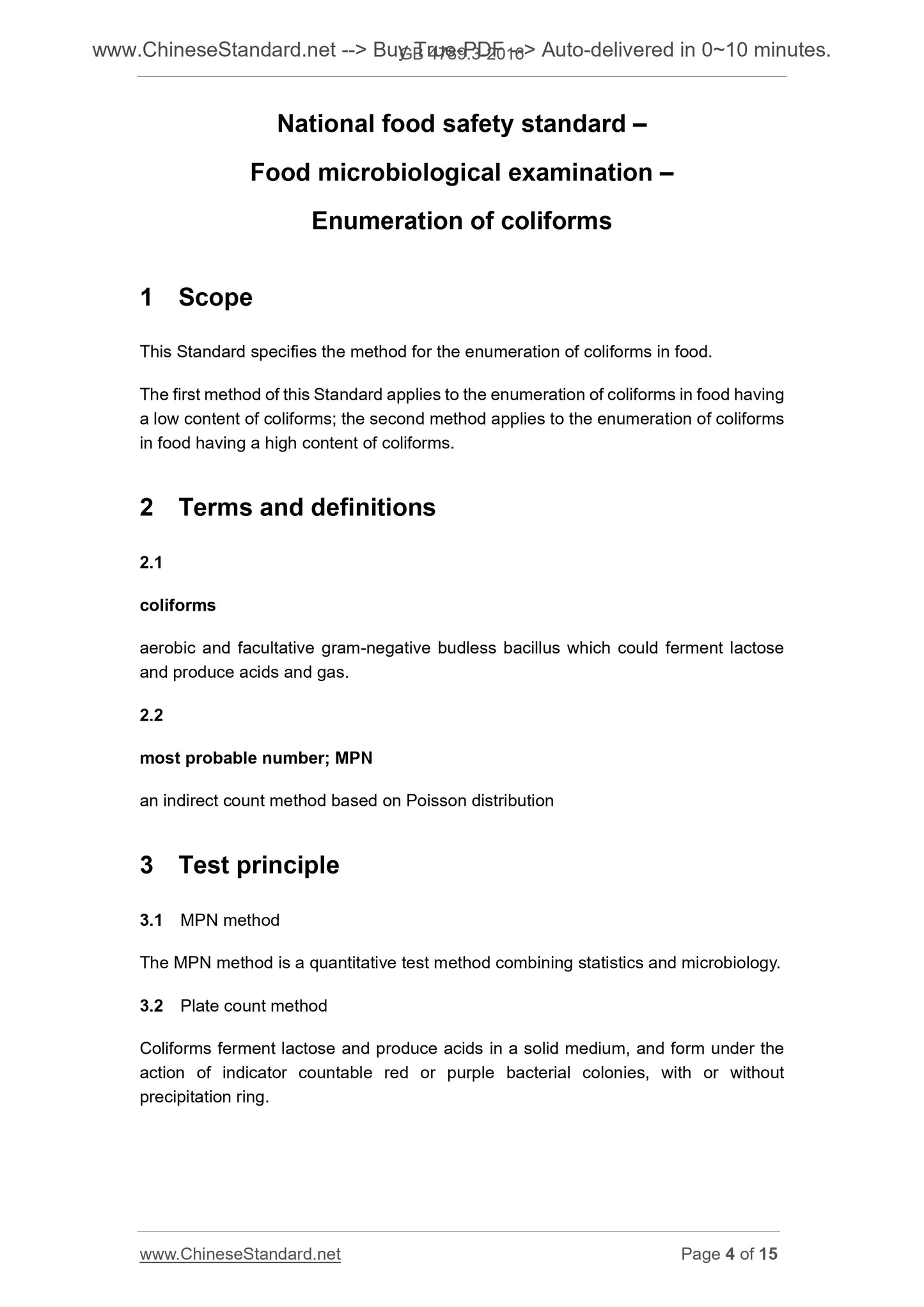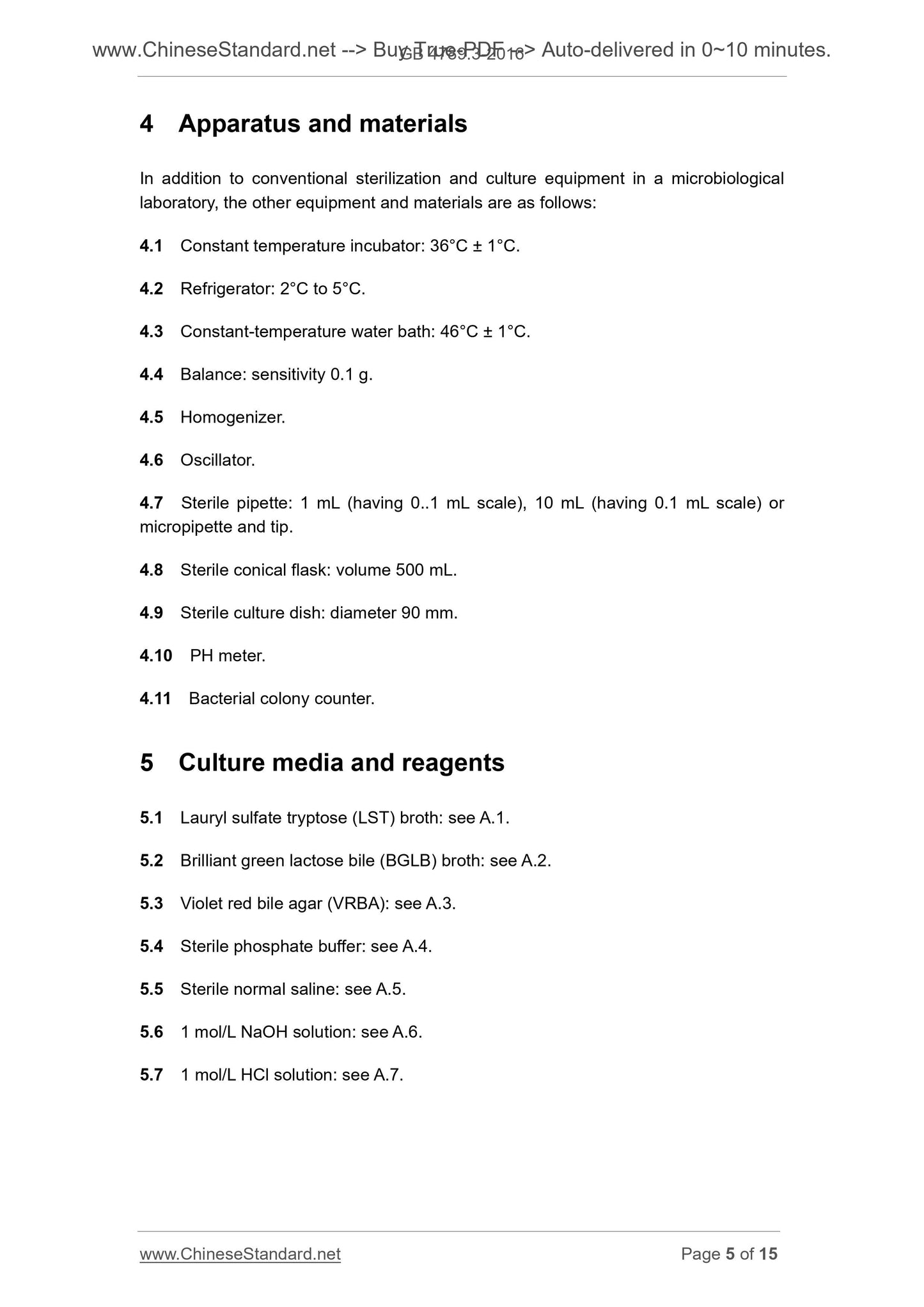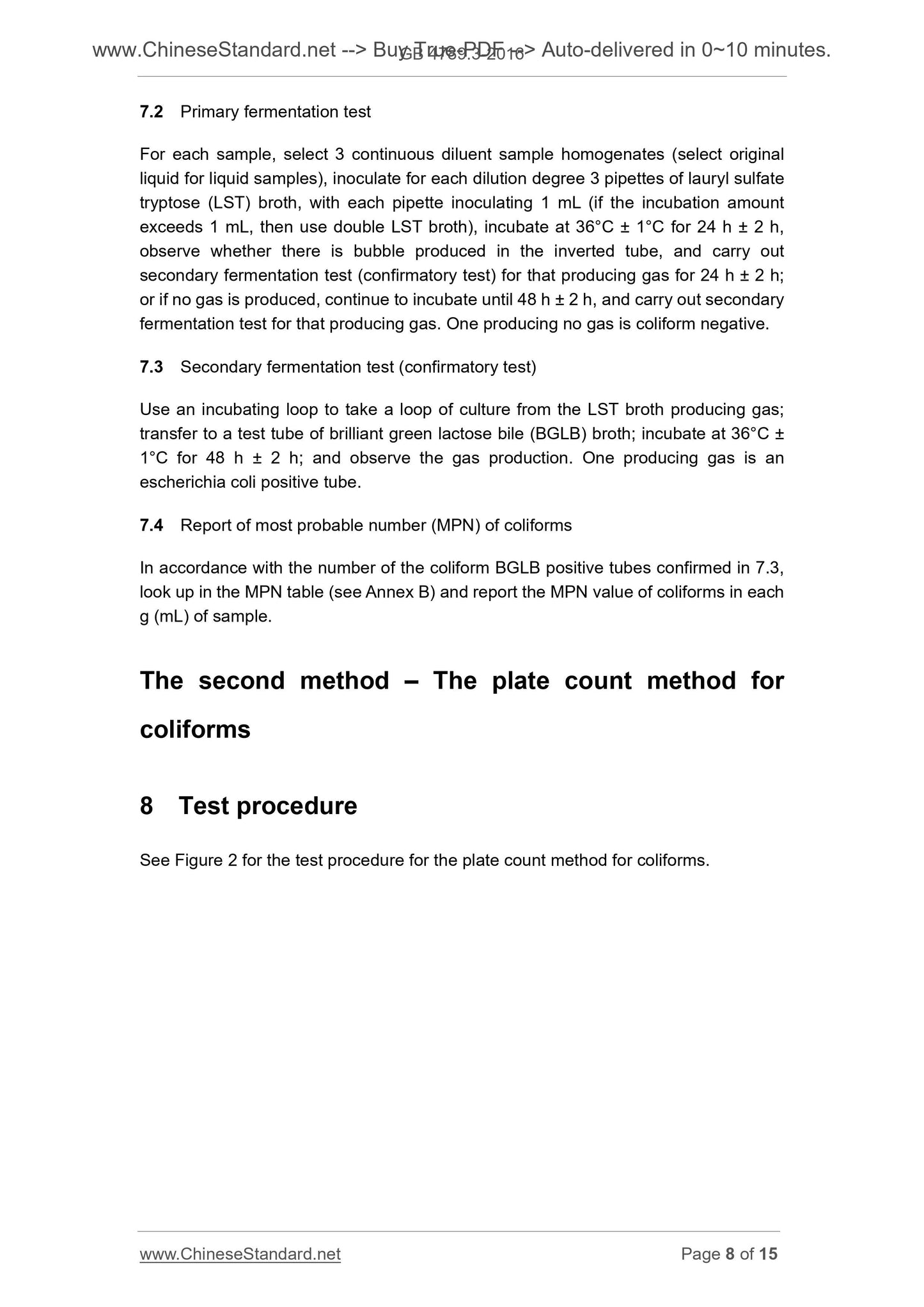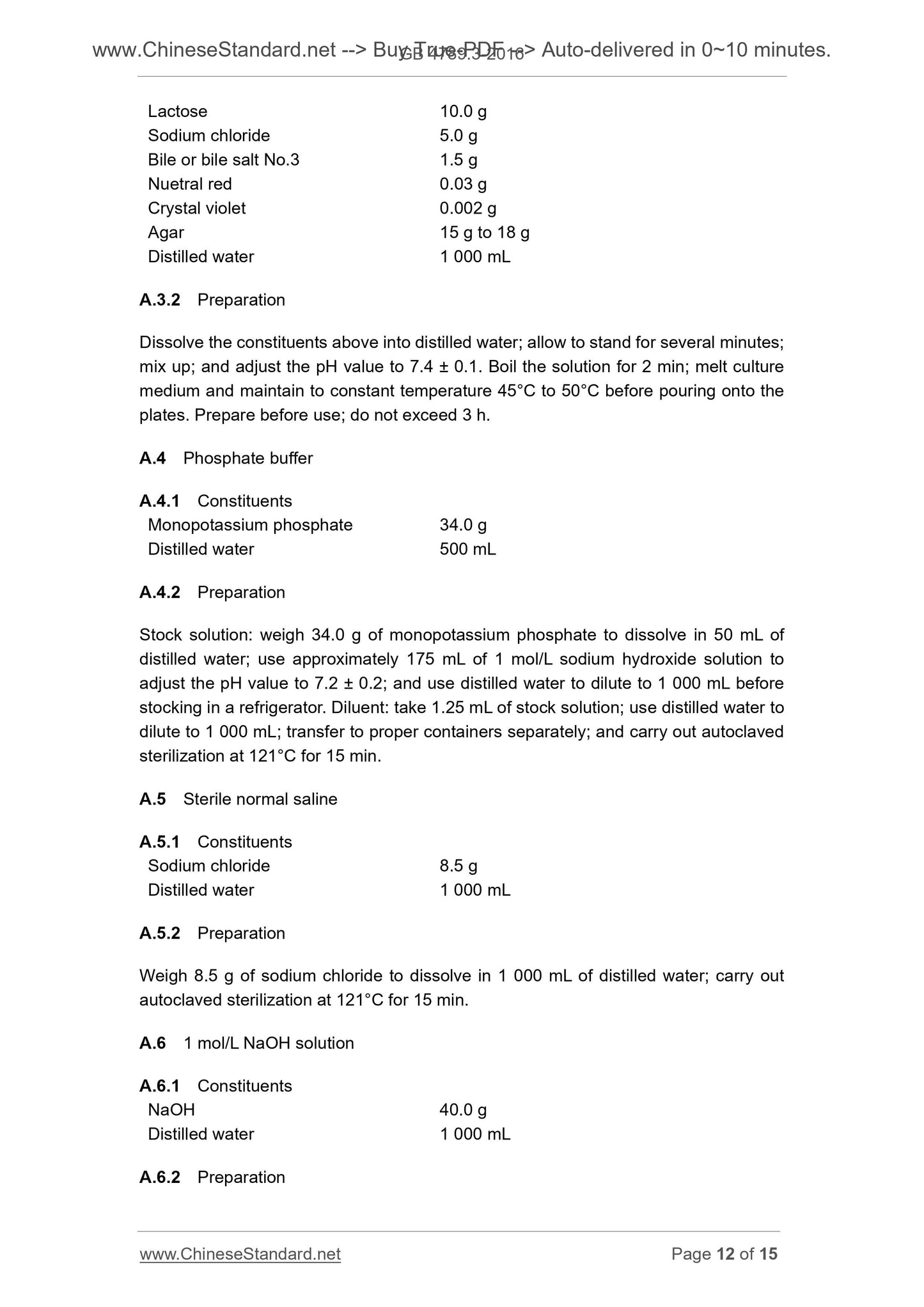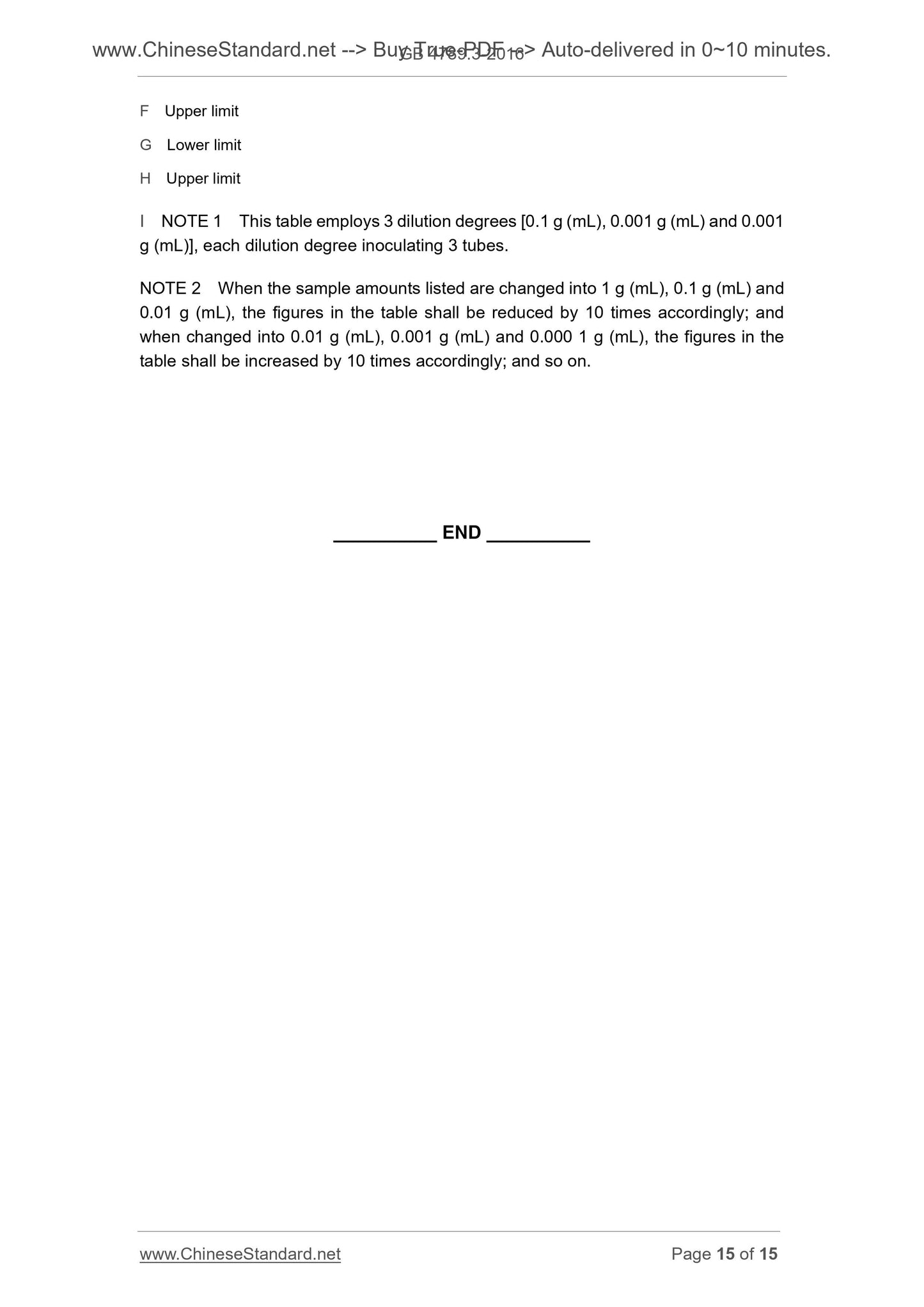1
/
of
8
PayPal, credit cards. Download editable-PDF & invoice in 1 second!
GB 4789.3-2016 English PDF
GB 4789.3-2016 English PDF
Regular price
$70.00 USD
Regular price
Sale price
$70.00 USD
Unit price
/
per
Shipping calculated at checkout.
Couldn't load pickup availability
Delivery: 3 seconds. Download true-PDF + Invoice.
Get Quotation: Click GB 4789.3-2016 (Self-service in 1-minute)
Historical versions (Master-website): GB 4789.3-2016
Preview True-PDF (Reload/Scroll-down if blank)
GB 4789.3-2016: National food safety standard - Food microbiological examination - Enumeration of coliforms
GB 4789.3-2016
GB
NATIONAL STANDARD OF THE
PEOPLE’S REPUBLIC OF CHINA
National food safety standard –
Food microbiological examination –
Enumeration of coliforms
ISSUED ON. DECEMBER 23, 2016
IMPLEMENTED ON. JUNE 23, 2017
Issued by. National Health and Family Planning Commission of the
People’s Republic of China;
China Food and Drug Administration.
Table of Contents
Foreword ... 3
1 Scope ... 4
2 Terms and definitions ... 4
3 Test principle ... 4
4 Apparatus and materials ... 5
5 Culture media and reagents ... 5
The first method – The MPN count method for coliforms ... 6
6 Test procedure ... 6
7 Operating procedure ... 7
The second method – The plate count method for coliforms ... 8
8 Test procedure ... 8
9 Operating procedure ... 9
Annex A Culture media and reagents ... 11
Annex B Coliform most probable number (MPN) key ... 14
Foreword
This Standard replaces GB 4789.3-2010, National food safety standard – Food
microbiological examination – Enumeration of coliforms, GB/T 4789.32-2002,
Microbiological examination for food hygiene – Rapid detection of coliform bacteria,
and SN/T 0169-2010, Determination of coliform, fecal coliform and escherichia coli in
food for import and export.
Compared with GB 4789.3-2010, the main changes of this Standard are as follows.
-- it adds the test principle;
-- it modifies the application scope;
-- it modifies the description of morphology of typical colony;
-- it modifies the selection of the second method for plate colony count;
-- it modifies the second method for confirmatory test; and
-- it modifies the report for the second method for plate count.
National food safety standard –
Food microbiological examination –
Enumeration of coliforms
1 Scope
This Standard specifies the method for the enumeration of coliforms in food.
The first method of this Standard applies to the enumeration of coliforms in food having
a low content of coliforms; the second method applies to the enumeration of coliforms
in food having a high content of coliforms.
2 Terms and definitions
2.1
coliforms
aerobic and facultative gram-negative budless bacillus which could ferment lactose
and produce acids and gas.
2.2
most probable number; MPN
an indirect count method based on Poisson distribution
3 Test principle
3.1 MPN method
The MPN method is a quantitative test method combining statistics and microbiology.
3.2 Plate count method
Coliforms ferment lactose and produce acids in a solid medium, and form under the
action of indicator countable red or purple bacterial colonies, with or without
precipitation ring.
4 Apparatus and materials
In addition to conventional sterilization and culture equipment in a microbiological
laboratory, the other equipment and materials are as follows.
4.1 Constant temperature incubator. 36°C ± 1°C.
4.2 Refrigerator. 2°C to 5°C.
4.3 Constant-temperature water bath. 46°C ± 1°C.
4.4 Balance. sensitivity 0.1 g.
4.5 Homogenizer.
4.6 Oscillator.
4.7 Sterile pipette. 1 mL (having 0..1 mL scale), 10 mL (having 0.1 mL scale) or
micropipette and tip.
4.8 Sterile conical flask. volume 500 mL.
4.9 Sterile culture dish. diameter 90 mm.
4.10 PH meter.
4.11 Bacterial colony counter.
5 Culture media and reagents
5.1 Lauryl sulfate tryptose (LST) broth. see A.1.
5.2 Brilliant green lactose bile (BGLB) broth. see A.2.
5.3 Violet red bile agar (VRBA). see A.3.
5.4 Sterile phosphate buffer. see A.4.
5.5 Sterile normal saline. see A.5.
5.6 1 mol/L NaOH solution. see A.6.
5.7 1 mol/L HCl solution. see A.7.
7.2 Primary fermentation test
For each sample, select 3 continuous diluent sample homogenates (select original
liquid for liquid samples), inoculate for each dilution degree 3 pipettes of lauryl sulfate
tryptose (LST) broth, with each pipette inoculating 1 mL (if the incubation amount
exceeds 1 mL, then use double LST broth), incubate at 36°C ± 1°C for 24 h ± 2 h,
observe whether there is bubble produced in the inverted tube, and carry out
secondary fermentation test (confirmatory test) for that producing gas for 24 h ± 2 h;
or if no gas is produced, continue to incubate until 48 h ± 2 h, and carry out secondary
fermentation test for that producing gas. One producing no gas is coliform negative.
7.3 Secondary fermentation test (confirmatory test)
Use an incubating loop to take a loop of culture from the LST broth producing gas;
transfer to a test tube of brilliant green lactose bile (BGLB) broth; incubate at 36°C ±
1°C for 48 h ± 2 h; and observe the gas production. One producing gas is an
escherichia coli positive tube.
7.4 Report of most probable number (MPN) of coliforms
In accordance with the number of the coliform BGLB positive tubes confirmed in 7.3,
look up in the MPN table (see Annex B) and report the MPN value of coliforms in each
g (mL) of sample.
The second method – The plate count method for
coliforms
8 Test procedure
See Figure 2 for the test procedure for the plate count method for coliforms.
Lactose 10.0 g
Sodium chloride 5.0 g
Bile or bile salt No.3 1.5 g
Nuetral red 0.03 g
Crystal violet 0.002 g
Agar 15 g to 18 g
Distilled water 1 000 mL
A.3.2 Preparation
Dissolve the constituents above into distilled water; allow to stand for several minutes;
mix up; and adjust the pH value to 7.4 ± 0.1. Boil the solution for 2 min; melt culture
medium and maintain to constant temperature 45°C to 50°C before pouring onto the
plates. Prepare before use; do not exceed 3 h.
A.4 Phosphate buffer
A.4.1 Constituents
Monopotassium phosphate 34.0 g
Distilled water 500 mL
A.4.2 Preparation
Stock solution. weigh 34.0 g of monopotassium phosphate to dissolve in 50 mL of
distilled water; use approximately 175 mL of 1 mol/L sodium hydroxide solution to
adjust the pH value to 7.2 ± 0.2; and use distilled water to dilute to 1 000 mL before
stocking in a refrigerator. Diluent. take 1.25 mL of stock solution; use distilled water to
dilute to 1 000 mL; transfer to proper containers separately; and carry out autoclaved
sterilization at 121°C for 15 min.
A.5 Sterile normal saline
A.5.1 Constituents
Sodium chloride 8.5 g
Distilled water 1 000 mL
A.5.2 Preparation
Weigh 8.5 g of sodium chloride to dissolve in 1 000 mL of distilled water; carry out
autoclaved sterilization at 121°C for 15 min.
A.6 1 mol/L NaOH solution
A.6.1 Constituents
NaOH 40.0 g
Distilled water 1 000 mL
A.6.2 Preparation
F Upper limit
G Lower limit
H Upper limit
I NOTE 1 This table employs 3 dilution degrees [0.1 g (mL), 0.001 g (mL) and 0.001
g (mL)], each dilution degree inoculating 3 tubes.
NOTE 2 When the sample amounts listed are changed into 1 g (mL), 0.1 g (mL) and
0.01 g (mL), the figures in the table shall be reduced by 10 times accordingly; and
when changed into 0.01 g (mL), 0.001 g (mL) and 0.000 1 g (mL), the figures in the
table shall be increased by 10 times accordingly; and so on.
GB 4789.3-2016
GB
NATIONAL STANDARD OF THE
PEOPLE’S REPUBLIC OF CHINA
National food safety standard –
Food microbiological examination –
Enumeration of coliforms
ISSUED ON. DECEMBER 23, 2016
IMPLEMENTED ON. JUNE 23, 2017
Issued by. National Health and Family Planning Commission of the
People’s Republic of China;
China Food and Drug Administration.
Table of Contents
Foreword ... 3
1 Scope ... 4
2 Terms and definitions ... 4
3 Test principle ... 4
4 Apparatus and materials ... 5
5 Culture media and reagents ... 5
The first method – The MPN count method for coliforms ... 6
6 Test procedure ... 6
7 Operating procedure ... 7
The second method – The plate count method for coliforms ... 8
8 Test procedure ... 8
9 Operating procedure ... 9
Annex A Culture media and reagents ... 11
Annex B Coliform most probable number (MPN) key ... 14
Foreword
This Standard replaces GB 4789.3-2010, National food safety standard – Food
microbiological examination – Enumeration of coliforms, GB/T 4789.32-2002,
Microbiological examination for food hygiene – Rapid detection of coliform bacteria,
and SN/T 0169-2010, Determination of coliform, fecal coliform and escherichia coli in
food for import and export.
Compared with GB 4789.3-2010, the main changes of this Standard are as follows.
-- it adds the test principle;
-- it modifies the application scope;
-- it modifies the description of morphology of typical colony;
-- it modifies the selection of the second method for plate colony count;
-- it modifies the second method for confirmatory test; and
-- it modifies the report for the second method for plate count.
National food safety standard –
Food microbiological examination –
Enumeration of coliforms
1 Scope
This Standard specifies the method for the enumeration of coliforms in food.
The first method of this Standard applies to the enumeration of coliforms in food having
a low content of coliforms; the second method applies to the enumeration of coliforms
in food having a high content of coliforms.
2 Terms and definitions
2.1
coliforms
aerobic and facultative gram-negative budless bacillus which could ferment lactose
and produce acids and gas.
2.2
most probable number; MPN
an indirect count method based on Poisson distribution
3 Test principle
3.1 MPN method
The MPN method is a quantitative test method combining statistics and microbiology.
3.2 Plate count method
Coliforms ferment lactose and produce acids in a solid medium, and form under the
action of indicator countable red or purple bacterial colonies, with or without
precipitation ring.
4 Apparatus and materials
In addition to conventional sterilization and culture equipment in a microbiological
laboratory, the other equipment and materials are as follows.
4.1 Constant temperature incubator. 36°C ± 1°C.
4.2 Refrigerator. 2°C to 5°C.
4.3 Constant-temperature water bath. 46°C ± 1°C.
4.4 Balance. sensitivity 0.1 g.
4.5 Homogenizer.
4.6 Oscillator.
4.7 Sterile pipette. 1 mL (having 0..1 mL scale), 10 mL (having 0.1 mL scale) or
micropipette and tip.
4.8 Sterile conical flask. volume 500 mL.
4.9 Sterile culture dish. diameter 90 mm.
4.10 PH meter.
4.11 Bacterial colony counter.
5 Culture media and reagents
5.1 Lauryl sulfate tryptose (LST) broth. see A.1.
5.2 Brilliant green lactose bile (BGLB) broth. see A.2.
5.3 Violet red bile agar (VRBA). see A.3.
5.4 Sterile phosphate buffer. see A.4.
5.5 Sterile normal saline. see A.5.
5.6 1 mol/L NaOH solution. see A.6.
5.7 1 mol/L HCl solution. see A.7.
7.2 Primary fermentation test
For each sample, select 3 continuous diluent sample homogenates (select original
liquid for liquid samples), inoculate for each dilution degree 3 pipettes of lauryl sulfate
tryptose (LST) broth, with each pipette inoculating 1 mL (if the incubation amount
exceeds 1 mL, then use double LST broth), incubate at 36°C ± 1°C for 24 h ± 2 h,
observe whether there is bubble produced in the inverted tube, and carry out
secondary fermentation test (confirmatory test) for that producing gas for 24 h ± 2 h;
or if no gas is produced, continue to incubate until 48 h ± 2 h, and carry out secondary
fermentation test for that producing gas. One producing no gas is coliform negative.
7.3 Secondary fermentation test (confirmatory test)
Use an incubating loop to take a loop of culture from the LST broth producing gas;
transfer to a test tube of brilliant green lactose bile (BGLB) broth; incubate at 36°C ±
1°C for 48 h ± 2 h; and observe the gas production. One producing gas is an
escherichia coli positive tube.
7.4 Report of most probable number (MPN) of coliforms
In accordance with the number of the coliform BGLB positive tubes confirmed in 7.3,
look up in the MPN table (see Annex B) and report the MPN value of coliforms in each
g (mL) of sample.
The second method – The plate count method for
coliforms
8 Test procedure
See Figure 2 for the test procedure for the plate count method for coliforms.
Lactose 10.0 g
Sodium chloride 5.0 g
Bile or bile salt No.3 1.5 g
Nuetral red 0.03 g
Crystal violet 0.002 g
Agar 15 g to 18 g
Distilled water 1 000 mL
A.3.2 Preparation
Dissolve the constituents above into distilled water; allow to stand for several minutes;
mix up; and adjust the pH value to 7.4 ± 0.1. Boil the solution for 2 min; melt culture
medium and maintain to constant temperature 45°C to 50°C before pouring onto the
plates. Prepare before use; do not exceed 3 h.
A.4 Phosphate buffer
A.4.1 Constituents
Monopotassium phosphate 34.0 g
Distilled water 500 mL
A.4.2 Preparation
Stock solution. weigh 34.0 g of monopotassium phosphate to dissolve in 50 mL of
distilled water; use approximately 175 mL of 1 mol/L sodium hydroxide solution to
adjust the pH value to 7.2 ± 0.2; and use distilled water to dilute to 1 000 mL before
stocking in a refrigerator. Diluent. take 1.25 mL of stock solution; use distilled water to
dilute to 1 000 mL; transfer to proper containers separately; and carry out autoclaved
sterilization at 121°C for 15 min.
A.5 Sterile normal saline
A.5.1 Constituents
Sodium chloride 8.5 g
Distilled water 1 000 mL
A.5.2 Preparation
Weigh 8.5 g of sodium chloride to dissolve in 1 000 mL of distilled water; carry out
autoclaved sterilization at 121°C for 15 min.
A.6 1 mol/L NaOH solution
A.6.1 Constituents
NaOH 40.0 g
Distilled water 1 000 mL
A.6.2 Preparation
F Upper limit
G Lower limit
H Upper limit
I NOTE 1 This table employs 3 dilution degrees [0.1 g (mL), 0.001 g (mL) and 0.001
g (mL)], each dilution degree inoculating 3 tubes.
NOTE 2 When the sample amounts listed are changed into 1 g (mL), 0.1 g (mL) and
0.01 g (mL), the figures in the table shall be reduced by 10 times accordingly; and
when changed into 0.01 g (mL), 0.0...
Get Quotation: Click GB 4789.3-2016 (Self-service in 1-minute)
Historical versions (Master-website): GB 4789.3-2016
Preview True-PDF (Reload/Scroll-down if blank)
GB 4789.3-2016: National food safety standard - Food microbiological examination - Enumeration of coliforms
GB 4789.3-2016
GB
NATIONAL STANDARD OF THE
PEOPLE’S REPUBLIC OF CHINA
National food safety standard –
Food microbiological examination –
Enumeration of coliforms
ISSUED ON. DECEMBER 23, 2016
IMPLEMENTED ON. JUNE 23, 2017
Issued by. National Health and Family Planning Commission of the
People’s Republic of China;
China Food and Drug Administration.
Table of Contents
Foreword ... 3
1 Scope ... 4
2 Terms and definitions ... 4
3 Test principle ... 4
4 Apparatus and materials ... 5
5 Culture media and reagents ... 5
The first method – The MPN count method for coliforms ... 6
6 Test procedure ... 6
7 Operating procedure ... 7
The second method – The plate count method for coliforms ... 8
8 Test procedure ... 8
9 Operating procedure ... 9
Annex A Culture media and reagents ... 11
Annex B Coliform most probable number (MPN) key ... 14
Foreword
This Standard replaces GB 4789.3-2010, National food safety standard – Food
microbiological examination – Enumeration of coliforms, GB/T 4789.32-2002,
Microbiological examination for food hygiene – Rapid detection of coliform bacteria,
and SN/T 0169-2010, Determination of coliform, fecal coliform and escherichia coli in
food for import and export.
Compared with GB 4789.3-2010, the main changes of this Standard are as follows.
-- it adds the test principle;
-- it modifies the application scope;
-- it modifies the description of morphology of typical colony;
-- it modifies the selection of the second method for plate colony count;
-- it modifies the second method for confirmatory test; and
-- it modifies the report for the second method for plate count.
National food safety standard –
Food microbiological examination –
Enumeration of coliforms
1 Scope
This Standard specifies the method for the enumeration of coliforms in food.
The first method of this Standard applies to the enumeration of coliforms in food having
a low content of coliforms; the second method applies to the enumeration of coliforms
in food having a high content of coliforms.
2 Terms and definitions
2.1
coliforms
aerobic and facultative gram-negative budless bacillus which could ferment lactose
and produce acids and gas.
2.2
most probable number; MPN
an indirect count method based on Poisson distribution
3 Test principle
3.1 MPN method
The MPN method is a quantitative test method combining statistics and microbiology.
3.2 Plate count method
Coliforms ferment lactose and produce acids in a solid medium, and form under the
action of indicator countable red or purple bacterial colonies, with or without
precipitation ring.
4 Apparatus and materials
In addition to conventional sterilization and culture equipment in a microbiological
laboratory, the other equipment and materials are as follows.
4.1 Constant temperature incubator. 36°C ± 1°C.
4.2 Refrigerator. 2°C to 5°C.
4.3 Constant-temperature water bath. 46°C ± 1°C.
4.4 Balance. sensitivity 0.1 g.
4.5 Homogenizer.
4.6 Oscillator.
4.7 Sterile pipette. 1 mL (having 0..1 mL scale), 10 mL (having 0.1 mL scale) or
micropipette and tip.
4.8 Sterile conical flask. volume 500 mL.
4.9 Sterile culture dish. diameter 90 mm.
4.10 PH meter.
4.11 Bacterial colony counter.
5 Culture media and reagents
5.1 Lauryl sulfate tryptose (LST) broth. see A.1.
5.2 Brilliant green lactose bile (BGLB) broth. see A.2.
5.3 Violet red bile agar (VRBA). see A.3.
5.4 Sterile phosphate buffer. see A.4.
5.5 Sterile normal saline. see A.5.
5.6 1 mol/L NaOH solution. see A.6.
5.7 1 mol/L HCl solution. see A.7.
7.2 Primary fermentation test
For each sample, select 3 continuous diluent sample homogenates (select original
liquid for liquid samples), inoculate for each dilution degree 3 pipettes of lauryl sulfate
tryptose (LST) broth, with each pipette inoculating 1 mL (if the incubation amount
exceeds 1 mL, then use double LST broth), incubate at 36°C ± 1°C for 24 h ± 2 h,
observe whether there is bubble produced in the inverted tube, and carry out
secondary fermentation test (confirmatory test) for that producing gas for 24 h ± 2 h;
or if no gas is produced, continue to incubate until 48 h ± 2 h, and carry out secondary
fermentation test for that producing gas. One producing no gas is coliform negative.
7.3 Secondary fermentation test (confirmatory test)
Use an incubating loop to take a loop of culture from the LST broth producing gas;
transfer to a test tube of brilliant green lactose bile (BGLB) broth; incubate at 36°C ±
1°C for 48 h ± 2 h; and observe the gas production. One producing gas is an
escherichia coli positive tube.
7.4 Report of most probable number (MPN) of coliforms
In accordance with the number of the coliform BGLB positive tubes confirmed in 7.3,
look up in the MPN table (see Annex B) and report the MPN value of coliforms in each
g (mL) of sample.
The second method – The plate count method for
coliforms
8 Test procedure
See Figure 2 for the test procedure for the plate count method for coliforms.
Lactose 10.0 g
Sodium chloride 5.0 g
Bile or bile salt No.3 1.5 g
Nuetral red 0.03 g
Crystal violet 0.002 g
Agar 15 g to 18 g
Distilled water 1 000 mL
A.3.2 Preparation
Dissolve the constituents above into distilled water; allow to stand for several minutes;
mix up; and adjust the pH value to 7.4 ± 0.1. Boil the solution for 2 min; melt culture
medium and maintain to constant temperature 45°C to 50°C before pouring onto the
plates. Prepare before use; do not exceed 3 h.
A.4 Phosphate buffer
A.4.1 Constituents
Monopotassium phosphate 34.0 g
Distilled water 500 mL
A.4.2 Preparation
Stock solution. weigh 34.0 g of monopotassium phosphate to dissolve in 50 mL of
distilled water; use approximately 175 mL of 1 mol/L sodium hydroxide solution to
adjust the pH value to 7.2 ± 0.2; and use distilled water to dilute to 1 000 mL before
stocking in a refrigerator. Diluent. take 1.25 mL of stock solution; use distilled water to
dilute to 1 000 mL; transfer to proper containers separately; and carry out autoclaved
sterilization at 121°C for 15 min.
A.5 Sterile normal saline
A.5.1 Constituents
Sodium chloride 8.5 g
Distilled water 1 000 mL
A.5.2 Preparation
Weigh 8.5 g of sodium chloride to dissolve in 1 000 mL of distilled water; carry out
autoclaved sterilization at 121°C for 15 min.
A.6 1 mol/L NaOH solution
A.6.1 Constituents
NaOH 40.0 g
Distilled water 1 000 mL
A.6.2 Preparation
F Upper limit
G Lower limit
H Upper limit
I NOTE 1 This table employs 3 dilution degrees [0.1 g (mL), 0.001 g (mL) and 0.001
g (mL)], each dilution degree inoculating 3 tubes.
NOTE 2 When the sample amounts listed are changed into 1 g (mL), 0.1 g (mL) and
0.01 g (mL), the figures in the table shall be reduced by 10 times accordingly; and
when changed into 0.01 g (mL), 0.001 g (mL) and 0.000 1 g (mL), the figures in the
table shall be increased by 10 times accordingly; and so on.
GB 4789.3-2016
GB
NATIONAL STANDARD OF THE
PEOPLE’S REPUBLIC OF CHINA
National food safety standard –
Food microbiological examination –
Enumeration of coliforms
ISSUED ON. DECEMBER 23, 2016
IMPLEMENTED ON. JUNE 23, 2017
Issued by. National Health and Family Planning Commission of the
People’s Republic of China;
China Food and Drug Administration.
Table of Contents
Foreword ... 3
1 Scope ... 4
2 Terms and definitions ... 4
3 Test principle ... 4
4 Apparatus and materials ... 5
5 Culture media and reagents ... 5
The first method – The MPN count method for coliforms ... 6
6 Test procedure ... 6
7 Operating procedure ... 7
The second method – The plate count method for coliforms ... 8
8 Test procedure ... 8
9 Operating procedure ... 9
Annex A Culture media and reagents ... 11
Annex B Coliform most probable number (MPN) key ... 14
Foreword
This Standard replaces GB 4789.3-2010, National food safety standard – Food
microbiological examination – Enumeration of coliforms, GB/T 4789.32-2002,
Microbiological examination for food hygiene – Rapid detection of coliform bacteria,
and SN/T 0169-2010, Determination of coliform, fecal coliform and escherichia coli in
food for import and export.
Compared with GB 4789.3-2010, the main changes of this Standard are as follows.
-- it adds the test principle;
-- it modifies the application scope;
-- it modifies the description of morphology of typical colony;
-- it modifies the selection of the second method for plate colony count;
-- it modifies the second method for confirmatory test; and
-- it modifies the report for the second method for plate count.
National food safety standard –
Food microbiological examination –
Enumeration of coliforms
1 Scope
This Standard specifies the method for the enumeration of coliforms in food.
The first method of this Standard applies to the enumeration of coliforms in food having
a low content of coliforms; the second method applies to the enumeration of coliforms
in food having a high content of coliforms.
2 Terms and definitions
2.1
coliforms
aerobic and facultative gram-negative budless bacillus which could ferment lactose
and produce acids and gas.
2.2
most probable number; MPN
an indirect count method based on Poisson distribution
3 Test principle
3.1 MPN method
The MPN method is a quantitative test method combining statistics and microbiology.
3.2 Plate count method
Coliforms ferment lactose and produce acids in a solid medium, and form under the
action of indicator countable red or purple bacterial colonies, with or without
precipitation ring.
4 Apparatus and materials
In addition to conventional sterilization and culture equipment in a microbiological
laboratory, the other equipment and materials are as follows.
4.1 Constant temperature incubator. 36°C ± 1°C.
4.2 Refrigerator. 2°C to 5°C.
4.3 Constant-temperature water bath. 46°C ± 1°C.
4.4 Balance. sensitivity 0.1 g.
4.5 Homogenizer.
4.6 Oscillator.
4.7 Sterile pipette. 1 mL (having 0..1 mL scale), 10 mL (having 0.1 mL scale) or
micropipette and tip.
4.8 Sterile conical flask. volume 500 mL.
4.9 Sterile culture dish. diameter 90 mm.
4.10 PH meter.
4.11 Bacterial colony counter.
5 Culture media and reagents
5.1 Lauryl sulfate tryptose (LST) broth. see A.1.
5.2 Brilliant green lactose bile (BGLB) broth. see A.2.
5.3 Violet red bile agar (VRBA). see A.3.
5.4 Sterile phosphate buffer. see A.4.
5.5 Sterile normal saline. see A.5.
5.6 1 mol/L NaOH solution. see A.6.
5.7 1 mol/L HCl solution. see A.7.
7.2 Primary fermentation test
For each sample, select 3 continuous diluent sample homogenates (select original
liquid for liquid samples), inoculate for each dilution degree 3 pipettes of lauryl sulfate
tryptose (LST) broth, with each pipette inoculating 1 mL (if the incubation amount
exceeds 1 mL, then use double LST broth), incubate at 36°C ± 1°C for 24 h ± 2 h,
observe whether there is bubble produced in the inverted tube, and carry out
secondary fermentation test (confirmatory test) for that producing gas for 24 h ± 2 h;
or if no gas is produced, continue to incubate until 48 h ± 2 h, and carry out secondary
fermentation test for that producing gas. One producing no gas is coliform negative.
7.3 Secondary fermentation test (confirmatory test)
Use an incubating loop to take a loop of culture from the LST broth producing gas;
transfer to a test tube of brilliant green lactose bile (BGLB) broth; incubate at 36°C ±
1°C for 48 h ± 2 h; and observe the gas production. One producing gas is an
escherichia coli positive tube.
7.4 Report of most probable number (MPN) of coliforms
In accordance with the number of the coliform BGLB positive tubes confirmed in 7.3,
look up in the MPN table (see Annex B) and report the MPN value of coliforms in each
g (mL) of sample.
The second method – The plate count method for
coliforms
8 Test procedure
See Figure 2 for the test procedure for the plate count method for coliforms.
Lactose 10.0 g
Sodium chloride 5.0 g
Bile or bile salt No.3 1.5 g
Nuetral red 0.03 g
Crystal violet 0.002 g
Agar 15 g to 18 g
Distilled water 1 000 mL
A.3.2 Preparation
Dissolve the constituents above into distilled water; allow to stand for several minutes;
mix up; and adjust the pH value to 7.4 ± 0.1. Boil the solution for 2 min; melt culture
medium and maintain to constant temperature 45°C to 50°C before pouring onto the
plates. Prepare before use; do not exceed 3 h.
A.4 Phosphate buffer
A.4.1 Constituents
Monopotassium phosphate 34.0 g
Distilled water 500 mL
A.4.2 Preparation
Stock solution. weigh 34.0 g of monopotassium phosphate to dissolve in 50 mL of
distilled water; use approximately 175 mL of 1 mol/L sodium hydroxide solution to
adjust the pH value to 7.2 ± 0.2; and use distilled water to dilute to 1 000 mL before
stocking in a refrigerator. Diluent. take 1.25 mL of stock solution; use distilled water to
dilute to 1 000 mL; transfer to proper containers separately; and carry out autoclaved
sterilization at 121°C for 15 min.
A.5 Sterile normal saline
A.5.1 Constituents
Sodium chloride 8.5 g
Distilled water 1 000 mL
A.5.2 Preparation
Weigh 8.5 g of sodium chloride to dissolve in 1 000 mL of distilled water; carry out
autoclaved sterilization at 121°C for 15 min.
A.6 1 mol/L NaOH solution
A.6.1 Constituents
NaOH 40.0 g
Distilled water 1 000 mL
A.6.2 Preparation
F Upper limit
G Lower limit
H Upper limit
I NOTE 1 This table employs 3 dilution degrees [0.1 g (mL), 0.001 g (mL) and 0.001
g (mL)], each dilution degree inoculating 3 tubes.
NOTE 2 When the sample amounts listed are changed into 1 g (mL), 0.1 g (mL) and
0.01 g (mL), the figures in the table shall be reduced by 10 times accordingly; and
when changed into 0.01 g (mL), 0.0...
Share
